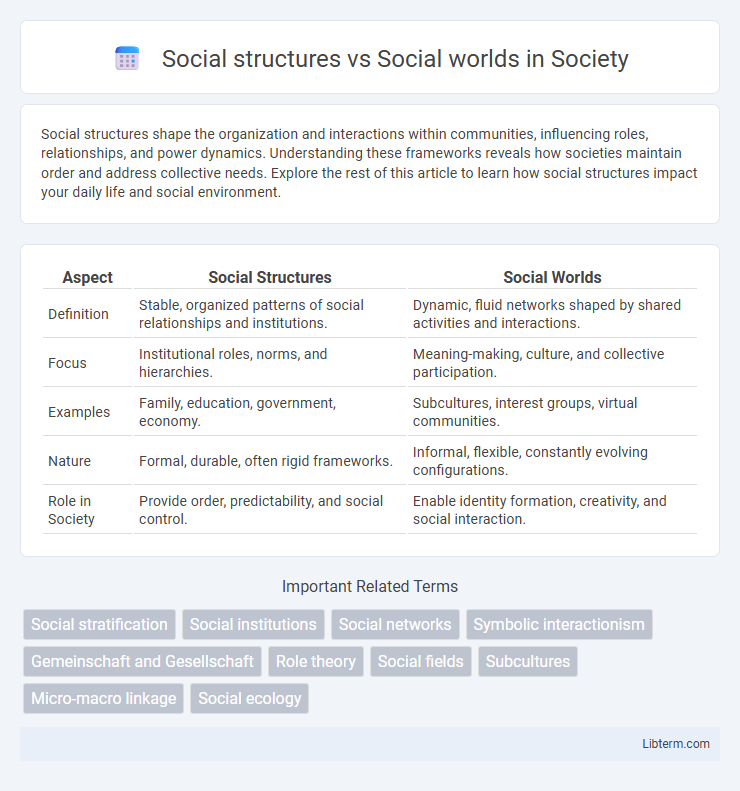Social structures shape the organization and interactions within communities, influencing roles, relationships, and power dynamics. Understanding these frameworks reveals how societies maintain order and address collective needs. Explore the rest of this article to learn how social structures impact your daily life and social environment.
Table of Comparison
| Aspect | Social Structures | Social Worlds |
|---|---|---|
| Definition | Stable, organized patterns of social relationships and institutions. | Dynamic, fluid networks shaped by shared activities and interactions. |
| Focus | Institutional roles, norms, and hierarchies. | Meaning-making, culture, and collective participation. |
| Examples | Family, education, government, economy. | Subcultures, interest groups, virtual communities. |
| Nature | Formal, durable, often rigid frameworks. | Informal, flexible, constantly evolving configurations. |
| Role in Society | Provide order, predictability, and social control. | Enable identity formation, creativity, and social interaction. |
Defining Social Structures
Social structures refer to the organized patterns of relationships and institutions that shape society, including roles, norms, and hierarchies influencing individual behavior and group interactions. These structures provide stability and predictability, encompassing entities such as family systems, legal frameworks, economic classes, and educational institutions. Understanding social structures reveals how power dynamics and resource distribution are maintained across different social layers and contexts.
Understanding Social Worlds
Understanding social worlds involves exploring how individuals create and maintain shared meanings, identities, and interactions within specific contexts. Unlike social structures that emphasize organized patterns and institutional frameworks, social worlds center on dynamic, everyday experiences and collective practices shaping group identities. This perspective highlights fluid boundaries and the importance of communication in sustaining social worlds.
Key Differences Between Social Structures and Social Worlds
Social structures refer to the stable, organized patterns of relationships and institutions that shape society, while social worlds emphasize fluid, shared activities and meanings within groups or communities. Social structures are characterized by hierarchical organization and enduring roles, whereas social worlds prioritize dynamic interactions and collective identities. Key differences include the permanence and formalization of social structures versus the cultural, interpretive nature of social worlds.
Historical Evolution of Social Structures
Social structures have evolved through historical processes such as industrialization, urbanization, and political revolutions, shaping complex systems of class, race, and gender relations that govern societal organization. These structures provide a framework of enduring norms, roles, and institutions, which influence economic distribution, power dynamics, and social stratification across different eras. In contrast, social worlds emerge as fluid, dynamic spaces reflecting the everyday interactions and cultural practices within these larger structural contexts.
Formation and Dynamics of Social Worlds
Social worlds form through continuous social interactions and shared activities among individuals, creating fluid group boundaries that evolve over time. These worlds are dynamic and shaped by ongoing negotiations, identity construction, and collective meanings within the social interactions of participants. In contrast to rigid social structures, social worlds emphasize the emergent and adaptable nature of social reality based on interpersonal relationships and contexts.
Intersections: Where Structures Meet Worlds
Social structures refer to the organized patterns of relationships and institutions that shape societal behavior, while social worlds encompass the everyday experiences and interactions within specific communities. The intersection of social structures and social worlds occurs when institutional frameworks influence the norms, identities, and practices of individuals in particular social settings. Understanding these intersections reveals how macro-level forces and micro-level experiences co-construct social reality, affecting power dynamics and social inclusion.
Power and Hierarchies in Social Contexts
Power dynamics within social structures establish formal hierarchies that govern roles, responsibilities, and resource distribution, shaping individuals' positions in society. Social worlds, consisting of fluid and overlapping groups, reflect more dynamic power relations influenced by cultural norms, shared meanings, and interaction patterns. Analyzing power and hierarchies in these contexts reveals the interplay between institutionalized authority and negotiated social influence.
Social Identity: Roles in Structures and Worlds
Social identity emerges from the interplay between social structures and social worlds, where roles within structures represent formal expectations tied to institutions, while roles in social worlds are more fluid and shaped by everyday interactions. In social structures, roles are often predefined and hierarchical, reinforcing group membership and social order. Social worlds, in contrast, provide dynamic contexts where identities evolve through shared meanings and negotiated practices, allowing individuals to navigate multiple roles simultaneously.
Impacts on Individual and Group Behavior
Social structures shape individual and group behavior by providing stable frameworks such as institutions, norms, and hierarchies that influence roles, expectations, and resource distribution. Social worlds, characterized by shared meanings, practices, and interactions within specific communities, directly affect identity formation, socialization processes, and collective action. The interplay between enduring social structures and dynamic social worlds determines behavioral patterns, social cohesion, and group dynamics in diverse societal contexts.
Contemporary Examples and Future Trends
Social structures such as class systems, institutional hierarchies, and economic frameworks shape interactions within social worlds like online communities, professional networks, and interest-based groups. Contemporary examples include the gig economy's flexible work arrangements challenging traditional labor hierarchies and virtual reality platforms creating immersive social worlds that transcend physical boundaries. Future trends suggest increasing integration of artificial intelligence in social coordination, transforming social structures through decentralized organizations and evolving digital social worlds with enhanced connectivity and personalized experiences.
Social structures Infographic

 libterm.com
libterm.com